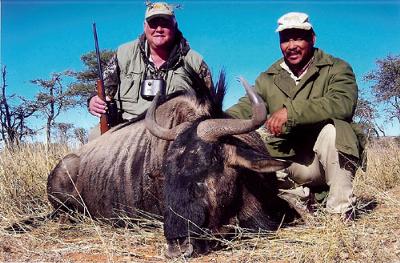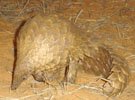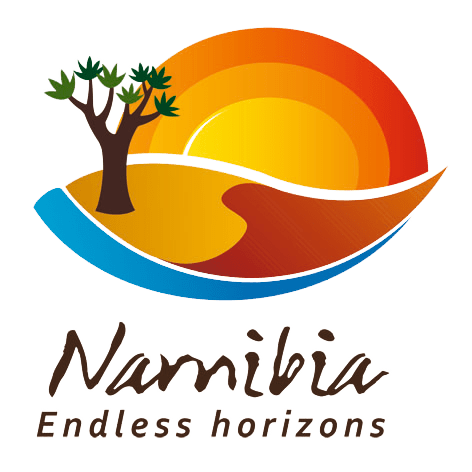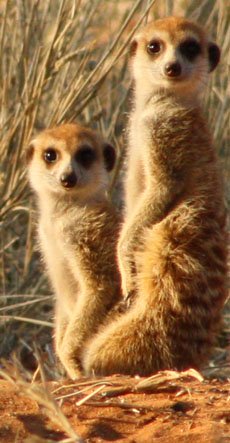For more information about our hunting safaris, don’t hesitate to reach out and contact us!
Conserving the Brindled Gnu
by Stephan Hofmann
(Illinois,USA)
The Blue Wildebeest is also called the Brindled Gnu because of the dark stripes on it's side which make for a beautiful skin or rug. The Black Wildebeest is also called the White-tailed Gnu because of it's long white tail. The Black Wildebeest is much smaller than the Blue Wildebeest. The Blue Wildebeest numbers in the millions in Kenya and Tanzania and constitutes a large portion of the animals that make up the annual migration that seasonally follow the grass in those countries.
I had never shot a Wildebeest. I suppose every hunter in Africa must shoot a Gnu because they represent the symbol of Africa. Every school child knows what a Gnu looks like.
When I arrived at the ranch I was greeted by the owner, Jan, and his wife, Marie. They were gracious hosts. They had the help bring my belongings to my room. Jan would be my guide and the Namibian raised Professional Hunters, Franz and Johannes, would drive for me and stalk with me.
The first thing to do was sight in my Ruger .300 Win Mag rifle. I had no worries about the accuracy of the rifle because my rifle had previously been finely tuned by Michael Duvenhage at Uitspan. Franz set up the targets and I shot one shot in the direct center of the target at 100 yards. Jan said that was good shooting. After sighting in the rifle we drove around the ranch. We saw a large herd of Black Wildebeest, many Springbok, Red Hartebeest, Ostrich, and Blesbok. The ranch was full of game. There were also many varieties of birds. We saw two large Secretary Birds sitting in a nest, Sand Grouse, three types of Doves, Francolin, a Reichsvogel or bird that had the colors of the old German flag, Kori Bustards, a Martial Eagle, a Pale Chanting Goshawk, and many Hornbills.
The sun was setting. We went back to the ranch house and Jan showed me to the Bar. He offered me a Windhoek Draft Beer which was cold and delicious. Jan gave me the rules of rifle safety for the ranch. He also showed me a book that showed where to shoot the animals in Africa. In Africa it is best to aim low just in front of the front shoulder. Usually I shoot animals just behind the front shoulder but the book said to shoot way low. I told Jan that I would follow the book.
Marie served dinner. During dinner Jan told Marie,’This Man can Shoot”. I was thankful to Michael Duvenhage for sighting in my rifle. Praise like this from an esteemed hunter like Jan is very welcome. The dinner consisted of well aged Gemsbok steaks. They were very good.
After Dinner I went to my room and organized my gear. I slept well that night.
For the next three days, Jan, Franz, Johannes, and I hunted hard and harvested a few exceptional animals. We hunted with a Land Rover and we sat at a water hole for Eland.
I was very successful and shot a Duiker that scored 35.8; Gold is 28, a Steenbok that scored 35; 28 is Gold, a Gold Medal Eland Bull, A Game Fields Medal Black Wildebeest, a Gold Medal Red Hartebeest, and a Gemsbok for meat. The Blue Wildebeest eluded us. Jan knew that there were five old bulls that were separated from the main herd. We search high and low for the Blue Wildebeest with no success.
One crisp morning there was frost on the long yellow grass. We drove steeply up into the mountains and glassed the area on the next mountain for Blue Wildebeest. Franz saw some stripes far below. There was a herd of Gemsbok, a herd of Zebra, and a few Blue Wildebeest. We got out the shooting sticks and I followed Franz after the Wildebeest.
Jan remained in the Land Rover and observed the action. We got to the bottom of the hill and started up the hill that the animals were on. I smelled a barnyard odor that I assumed was Zebra. The Zebra were running away from us up the hill. I could have gotten off a quick shot if I had been hunting Zebra. We came to where the Zebra had been. There was dung and crushed grass everywhere. We went further up the hill and the Gemsbok ran from us. Now, only the Blue Wildebeest were left. I thought they were to our right. Franz climbed high in an Acacia tree and scouted the area. He could only see the Zebra and Gemsbok far in the distance. Franz climbed out of the tree and joined me. We heard a snort to our right. It was the Blue Wildebeest. He took off at high speed and was gone,
Jan radioed Franz and said he would come to pick us up. We would not get the Blue Wildebeest that day.
That night, over a cold Windhoek, Jan said that we would hunt tomorrow morning for the Blue Wildebeest and cook a Duiker Potjie in the evening. Marie would be in Windhoek and Jan would cook for me. I had mentioned that I had enjoyed a great Duiker Potjie on Uitspan. The Duiker that I had shot was well aged and Jan said it would make a fine Potjie.
The next morning there was frost on the long yellow grass, again. The ranch was beautiful with it's numerous Acacia tress and long grass with the Mountains in the distance. We again drove up into the Mountains. Franz with his sharp eyes spotted the long lost herd of five old bull Blue Wildebeest. Jan was overjoyed and gave Franz a $100 bonus. The bulls were far below and it took an hour to get to them. Finally we got close to the Wildebeest. One old bull was very curious and stood looking at us at 180 yards. I took careful aim and hit the Wildebeest solidly. He dropped to his feet. Jan and Franz congratulated me.
We went up to the Wildebeest and Jan conducted his ceremony after harvesting an animal in the old German tradition. Jan cut three green sprigs. He laid one on the animal's belly to venerate the beast and give it the Hunter's respect. He put one sprig in the bull's mouth to signify it's last meal. Jan put some blood on the last sprig and gave it to me to insert in the left side of my hat for 24 hours. Jan said;"Weidemann's Heil" as he handed me the sprig. It meant, "Hail the hunter. Good hunt!" I replied, "Weidiemann's Dank" ;thus giving my thanks. It was a very profound ceremony and we took it seriously. It was the ultimate respect for the animal and the sport of hunting.
Jan, who is an official SCI measurer, taped my bull and he scored 162; not enough for a Gold, a Silver, or even a Bronze. However this was an old, old, venerable animal who had sired many sons and spread his genes throughout the herd. His teeth were missing and well worn. His horns were broomed and broken. In the old German Tradition carried on in Namibia, Jan gave the bull a Conservation Medal. German hunters are entirely satisfied with an old animal; not necessarily an animal with the longest horns.
We went back to the ranch house. I watched Franz and the skinners process my Blue Wildebeest. Jan got his Potjie pot, made a fire under the pot, added Duiker, vegetables, and a lot of white wine. He cooked it for five hours, continually adding wine to keep it from drying up. While we sat around the Potjie Pot, Jan scored my animals, added up my bill, and did other paperwork for my hunt. Franz brought me the Wildebeest’s heart and showed me where the bullet grazed it. I took the heart and pretended to take a big bite out of it. It was all in good fun and we took some pictures.
Jan got out some Jack Daniels and poured me a shot. We celebrated the hunt and the Blue Wildebeest and blessed the Duiker Potjie, which was very good.
It had been a wonderful hunt on a beautiful ranch with some very nice people.
Stephan Hofmann
Comments for Conserving the Brindled Gnu
|
||
|
||
|
||
|
||
Meaning of "Uitspan"
'Uitspan' is an Afrikaans word that means place of rest.
When the Boer settlers moved inland in Southern Africa in the 1800's, they used ox carts. When they found a spot with game, water and green grass, they arranged their ox carts into a circular laager for protection against wild animals and stopped for a rest.
They referred to such an action of relaxation for man and beast, as Uitspan.
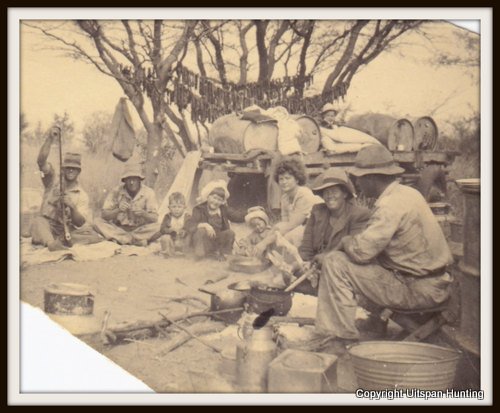
(Picture above of our ancestors.)
Did you know?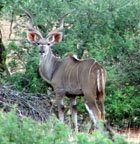 Greater Southern Kudus are famous for their ability to jump high fences. A 2 m (6.56 ft) fence is easily jumped while a 3 m (9.84 ft) high fence is jumped spontaneously. These strong jumpers are known to jump up to 3.5 m (11.48 ft) under stress. |
Did you know? Some animals have one sense more than man!The flehmen response is a particular type of curling of the upper lip in ungulates, felids and many other mammals. This action facilitates the transfer of pheromones and other scents into the vomeronasal organ, also called the Jacobson's Organ. Some animals have one sense more than man!The flehmen response is a particular type of curling of the upper lip in ungulates, felids and many other mammals. This action facilitates the transfer of pheromones and other scents into the vomeronasal organ, also called the Jacobson's Organ.This behavior allows animals to detect scents (for example from urine) of other members of their species or clues to the presence of prey. Flehming allows the animals to determine several factors, including the presence or absence of estrus, the physiological state of the animal, and how long ago the animal passed by. This particular response is recognizable in males when smelling the urine of a females in heat. |
